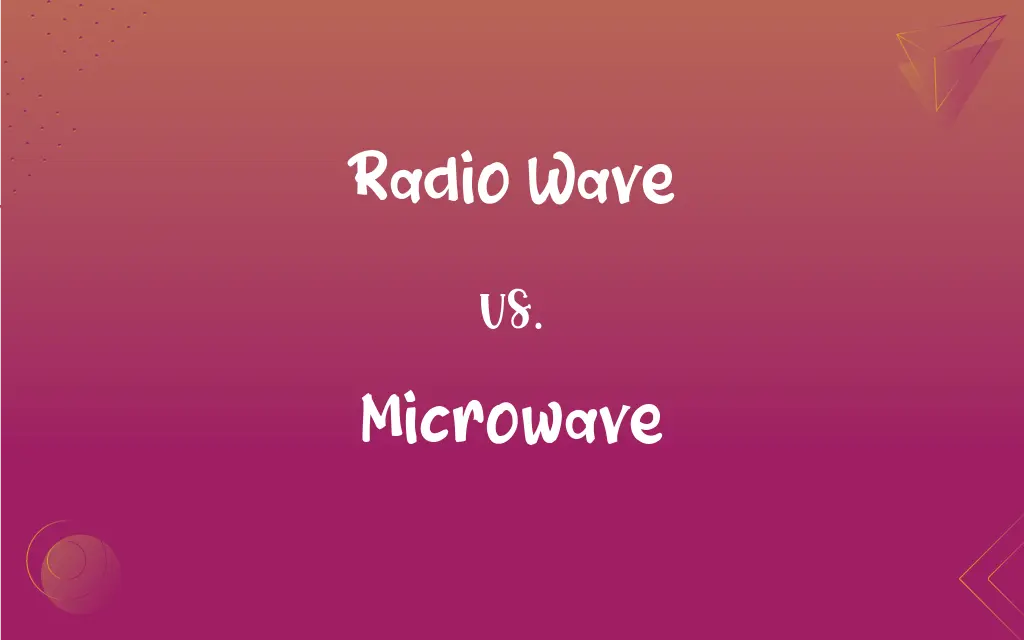Radio Wave vs. Microwave: What's the Difference?
Edited by Aimie Carlson || By Harlon Moss || Published on February 26, 2024
Radio waves have longer wavelengths and lower frequencies than microwaves; both are electromagnetic waves used for communication and other applications.

Key Differences
Radio waves are a type of electromagnetic radiation with wavelengths longer than microwaves. They range from about one millimeter to 100 kilometers in length. Microwaves, on the other hand, have shorter wavelengths, typically from about one millimeter to one meter. This difference in wavelength impacts their propagation and applications.
In terms of frequency, radio waves have a lower frequency range compared to microwaves. Radio waves typically range from 3 kHz to 300 GHz, while microwaves are in the higher frequency range, from 300 MHz to 300 GHz. Higher frequencies allow microwaves to carry more data, making them suitable for applications like GPS and mobile communications.
Radio waves are primarily used in communication systems such as radio and television broadcasting, mobile phones, and wireless networks. They have the ability to cover long distances and penetrate through obstacles. Microwaves, with their shorter wavelengths, are used in radar systems, satellite communications, and microwave ovens, where their ability to be directed in narrow beams is advantageous.
The propagation characteristics of radio waves allow them to travel long distances and bend around obstacles, making them ideal for broad-area coverage. Microwaves, due to their shorter wavelengths, have more line-of-sight propagation and are less able to diffract around obstacles.
Radio waves are generally safer for human exposure over prolonged periods, which is why they are widely used in commercial communication devices. Microwaves, particularly at high power levels, can pose health risks, such as tissue heating, and are thus used carefully in applications like microwave ovens and radar.
ADVERTISEMENT
Comparison Chart
Wavelength
Longer (1 mm to 100 km)
Shorter (1 mm to 1 m)
Frequency
Lower (3 kHz to 300 GHz)
Higher (300 MHz to 300 GHz)
Primary Uses
Broadcasting, mobile phones, wireless networks
Radar, satellite communications, microwave ovens
Propagation Characteristics
Long-distance travel, bends around obstacles
Line-of-sight, less diffraction
Safety for Human Exposure
Generally safer for prolonged exposure
High power can pose health risks
ADVERTISEMENT
Radio Wave and Microwave Definitions
Radio Wave
Generally safe for human exposure in common communication devices.
Mobile phones emit low-level radio waves that are considered safe.
Microwave
Shorter wavelength electromagnetic waves used in various technologies.
Microwaves in satellite communication transmit data across continents.
Radio Wave
Electromagnetic waves with longer wavelengths used in communication.
Radio waves enable broadcasts from a radio station to your car radio.
Microwave
Utilized in microwave ovens for heating food.
Microwave ovens heat food by agitating water molecules with microwaves.
Radio Wave
Can penetrate through obstacles, making them versatile for wireless networks.
Wi-Fi uses radio waves to transmit data through walls.
Microwave
Higher frequency waves suitable for data-intensive applications.
GPS systems rely on microwaves for precise location tracking.
Radio Wave
Ideal for broadcasting due to their broad coverage.
Television signals are broadcasted using radio waves.
Microwave
Used in radar systems due to their ability to form narrow beams.
Airport radars use microwaves to detect and track aircraft.
Radio Wave
Have lower frequencies suitable for long-distance communication.
Radio waves are used in maritime communications due to their long-range.
Microwave
Require careful handling due to potential health risks at high power.
Industrial microwave systems are shielded to protect operators from exposure.
Microwave
Relating to or being electromagnetic radiation between radio waves and infrared waves in the electromagnetic spectrum, having frequencies between 300 megahertz and 300 gigahertz and wavelengths between 1 meter and 1 millimeter.
FAQs
What are radio waves?
Electromagnetic waves used primarily for communication.
What are microwaves?
Electromagnetic waves with shorter wavelengths used in technology and cooking.
What is the wavelength range for microwaves?
Typically from one millimeter to one meter.
What are common uses of radio waves?
Broadcasting, mobile communication, and wireless networking.
How do radio wave frequencies compare to microwaves?
Radio waves have lower frequencies than microwaves.
Are microwaves line-of-sight?
Yes, they generally require line-of-sight for propagation.
Why are radio waves used in broadcasting?
Due to their ability to cover long distances and penetrate buildings.
What is the typical wavelength of radio waves?
From about one millimeter to 100 kilometers.
Can radio waves penetrate obstacles?
Yes, they can travel through and around obstacles.
Is prolonged exposure to radio waves safe?
Generally, yes, especially at low power levels.
What are microwaves used for?
Satellite communication, radar, and microwave ovens.
How do microwaves work in a microwave oven?
They heat food by agitating water molecules.
What is the frequency range of radio waves?
From 3 kHz to 300 GHz.
What frequency do microwaves operate at?
From 300 MHz to 300 GHz.
Why are microwaves suitable for satellite communication?
Due to their ability to transmit large amounts of data over long distances.
Are radio waves affected by the atmosphere?
Yes, their propagation can be influenced by atmospheric conditions.
Can microwaves cook food?
Yes, microwave ovens use them to heat and cook food.
What is the main difference between radio waves and microwaves?
The main difference is their wavelength and frequency, affecting their uses and propagation characteristics.
Are microwaves dangerous?
At high power levels, they can pose health risks.
Can radio waves be used for radar?
Yes, but microwaves are more commonly used due to their directional nature.
About Author
Written by
Harlon MossHarlon is a seasoned quality moderator and accomplished content writer for Difference Wiki. An alumnus of the prestigious University of California, he earned his degree in Computer Science. Leveraging his academic background, Harlon brings a meticulous and informed perspective to his work, ensuring content accuracy and excellence.
Edited by
Aimie CarlsonAimie Carlson, holding a master's degree in English literature, is a fervent English language enthusiast. She lends her writing talents to Difference Wiki, a prominent website that specializes in comparisons, offering readers insightful analyses that both captivate and inform.































































